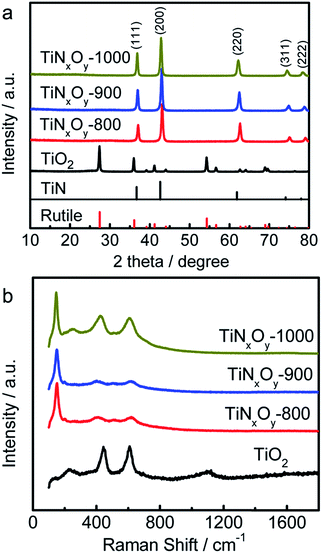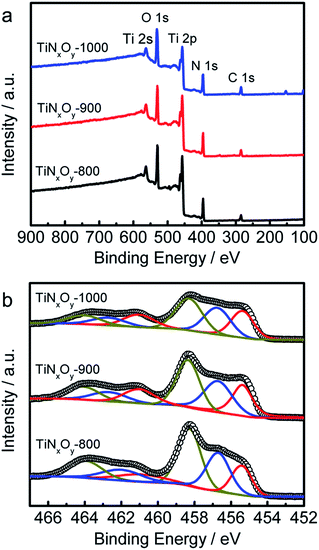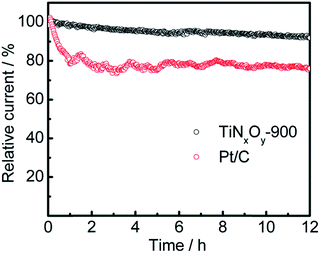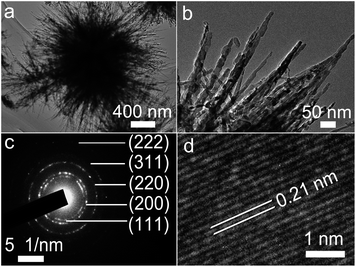Solvothermal synthesis of a dendritic TiNxOy nanostructure for oxygen reduction reaction electrocatalysis†
Yaqi Ren,
Zhonghua Ren,
Jianpeng Li,
Shuguang Wang and
Jie Yu*
Shenzhen Engineering Lab for Supercapacitor Materials, Shenzhen Key Laboratory for Advanced Materials, Department Material Science and Engineering, Shenzhen Graduate School, Harbin Institute of Technology, University Town, Shenzhen, China. E-mail: jyu@hitsz.edu.cn
First published on 8th December 2015
Abstract
A novel dendritic titanium oxynitride (TiNxOy) nanostructure composed of nanowires of 15–20 nm in diameter has been prepared. The dendritic TiNxOy nanostructure nitrided at 900 °C possesses high electrocatalytic activity for ORR with a four-electron process, high onset potential of −0.13 V, and superior durability compared with the commercial 10% Pt/C catalyst.
The oxygen reduction reaction (ORR) is an important process in fuel cells, and previous studies have indicated that the ORR reaction pathway is highly dependent on the nature and structure of the catalyst materials.1–6 Pt and its alloys are widely used as ORR catalysts, which allows a four-electron reduction process at relatively low overpotentials.7,8 However, owing to the high cost and poor durability of Pt, alternative catalysts based on non-precious metals such as transition metal oxides, nitrides, and carbides have been intensively pursued.9–11 Recently, transition metal nitrides, including TiN, Mo2N, VN, and WN etc., have attracted great attention as a new kind of promising electrocatalysts due to their low cost, outstanding catalytic activities, and noble metal-like properties originating from the electronic structures similar to those of noble metals.12–16 In particular, in terms of electrochemical stability and catalytic activity, titanium nitride (TiN) or titanium oxynitride (TiNxOy) may be the most promising electrocatalyst for ORR compared with many other transition metal nitrides.17–21
The electrocatalytic performance of the catalysts is strongly dependent on the exposure of active sites as the ORR occurs on the surface.22,23 It is thus of great importance to prepare appropriate nanostructures for the electrocatalysts to achieve good electrocatalytic performance. For example, Wang et al. studied the electrocatalytic activities of nano- and micro-sized TiN for ORR in alkaline media and concluded that the nano-sized TiN showed a much better catalytic activity compared with micro-sized TiN.24 Dong et al. reported that TiN nanotubes possess better electrocatalytic activity for ORR than TiN nanoparticles, indicating strong morphology dependence.22 Up to now, various TiN or TiNxOy nanostructures have been synthesized for diverse applications, including nanoparticles,25 nanorods,26 nanowires,27 and nanosheets.28 However, for the application of these nanomaterials one important problem is agglomeration, which decreases their active surface area and thus debases the performance. Therefore, it is necessary to take appropriate measures to make the nanomaterials well separated, making the surface exposed fully during application.
In this paper, we prepared a dendritic TiNxOy nanostructure composed of many radially oriented nanowires of about 15–20 nm in diameter. Because the TiNxOy nanowires are well separated and immobilized in the dendritic nanostructure, the problem of agglomeration can be effectively solved. To the best of our knowledge, this is the first time to report the preparation of the TiNxOy dendritic nanostructure. Due to the advantageous structure and high degree of nitridation the TiNxOy dendritic nanostructure shows excellent electrocatalytic performance for ORR with high onset potential at −0.13 V and excellent operation stability with current retention up to 91.7% after 12 h.
The dendritic TiNxOy nanostructure was prepared by solvothermal process and subsequent heat treatment in NH3 at different temperatures. The detailed preparation route is shown in Fig. 1. Fig. 2a shows the SEM image of TiO2 precursor prepared by the solvothermal process. It is indicated that the TiO2 precursor possesses a dendritic nanostructure. It is considered that both cetyltrimethyl ammonium bromide (CTAB) and ethylene glycol (EG) in the original solutions contribute to the formation of the particular morphology of TiO2.29 Fig. 2b and c show the SEM images of the TiNxOy dendritic nanostructure nitrided at 900 °C (TiNxOy-900). It is observed that the TiNxOy-900 still maintains the dendritic nanostructures, well inheriting the morphology of the TiO2 precursors. However, when heating at 1000 °C (the sample is named as TiNxOy-1000) the dendritic nanostructures of the TiO2 precursor collapsed, as shown in Fig. 2d. It is also noted that when heating at 800 °C in NH3 (the sample is named as TiNxOy-800) the morphology of the original TiO2 precursor can also be preserved.
 | ||
| Fig. 2 SEM images of the TiO2 sample after solvothermal process (a), TiNxOy-900 (b and c), and TiNxOy-1000 (d). | ||
Fig. 3a and b show the TEM images of TiNxOy-900. The diameter of the dendritic TiNxOy microsphere is about 3 μm and the microsphere is composed of radially oriented nanowires with diameters in a range of 15–20 nm and length about 1.2 μm (Fig. 3b). The selected area electron diffraction (SAED) pattern in Fig. 3c exhibits several clear diffraction rings pertaining to face-centered cubic (fcc) TiNxOy. From the high-resolution TEM (HRTEM) image of TiNxOy nanowires shown in Fig. 3d, well-defined lattice fringes are observed with a spacing of 0.21 nm, corresponding to (200) plane of TiNxOy. This is consistent with the SAED pattern.
Fig. 4a shows the XRD patterns of the dendritic TiO2 and TiNxOy microspheres. After heating the solvothermal synthesized products in O2 at 600 °C, the obtained oxides show several intense peaks of rutile TiO2 (JCPDS: 21-1276) and no carbon peaks can be found in the pattern. After the nitridation reaction at different temperatures, the obtained samples exhibit diffraction peaks at 36.7, 42.6, 61.8, 74.1, and 78.0°, corresponding to the (111), (200), (220), (311), and (222) planes of cubic TiN phase (JCPDS: 65-0714), respectively. This is well consistent with the SAED pattern and HRTEM image. It is observed that the position of (200) peak shifts to a lower degree with the increase of nitridation temperature, indicating an increased d-spacing. The calculated d-spacing of (200) plane for TiNxOy-800, TiNxOy-900, and TiNxOy-1000 are 0.209, 0.210, and 0.211 nm, respectively, in accordance with the HRTEM image shown in Fig. 3d. The increase of interplanar distance can be attributed to the increase of the N amount existing in the TiN lattice as interstitial atoms.30 Based on the Scherrer's equation the particle sizes of TiNxOy-800, TiNxOy-900, and TiNxOy-1000 were calculated to be 19.1, 19.5, and 20.2 nm, respectively, indicating that the particle size increases with increasing the nitriding temperature.
 | ||
| Fig. 4 XRD patterns (a) and Raman spectra (b) of the dendritic TiO2 and TiN nanostructures prepared at different nitridation temperature. | ||
The dendritic TiO2 and TiNxOy nanostructures were further characterized by Raman spectra, as shown in Fig. 4b. It is observed that the Raman spectra change a lot after the nitridation reaction and the peaks in the wavenumber region from 100 to 1000 cm−1 correspond to the TiNxOy phase.17,22 Meanwhile, no carbon characteristic peaks can be found in the Raman spectra, indicating that the carbon element has been removed during heat treatment in O2.
Fig. 5a shows the XPS spectra of TiNxOy samples at different nitridation temperature. It is found that all the TiNxOy samples contain Ti, N, and O elements. However, due to the high detection resolution of the XPS C element was detected for the TiNxOy samples, which may originate from the chemicals used in the solvothermal process and exist as dopant or impurity. Fig. 5b shows the deconvoluted Ti 2p peaks for the dendritic TiNxOy microspheres, where Ti–O bond at 458.4 and 464.2 eV (dark yellow), Ti–N–O bond at 456.8 and 462.8 eV (blue), and Ti–N bond at 455.3 and 461.1 eV (red) can be observed.31–34 The proportions of the Ti atoms existing in the forms of Ti–O bond and Ti–N bond were calculated. It is indicated that the proportion of Ti atoms existing in Ti–O bond decreases obviously from 45.9% to 41.7% and 38.8% while that in Ti–N bond increases from 20.7% to 27.7% and 31.9% when increasing the nitridation temperature from 800 to 900 and 1000 °C. The relatively high proportion of Ti–O bond on the surface is mainly due to inefficient nitridation and air oxidation.35 Since the higher nitrogen content in TiNxOy could introduce more trivalent titanium (Ti3+) and lead to increased conductivity,35 the increased proportion of Ti–N bond may contribute to the catalytic activity for the ORR. In addition, to further confirm the bulk composition of the dendritic TiNxOy nanostructure, XPS spectrum of TiNxOy-900 was measured after argon ion bombardment for 120 s (Fig. S1†). It is found that after the argon ion bombardment the TiNxOy-900 still contain Ti, N, and O elements, similar to the surface.
 | ||
| Fig. 5 XPS survey spectra (a) and Ti 2p XPS spectra (b) of the TiNxOy samples prepared at different nitridation temperature. | ||
The electrocatalytic performance of the dendritic TiNxOy nanostructure was evaluated by cyclic voltammetry (CV) and linear sweep voltammetry (LSV) in O2-saturated 0.1 M KOH electrolyte, as shown in Fig. 6. The CV curves in Fig. 6a recorded at a scan rate of 10 mV s−1 show well-defined oxygen reduction peaks at −0.29 V, −0.27 V, and −0.29 V for TiNxOy-800, TiNxOy-900, and TiNxOy-1000 samples, respectively. Fig. 6b shows the RDE curves of the different TiNxOy samples at a rotation speed of 1600 rpm and a scan rate of 10 mV s−1. In the RDE curves, the onset potentials for TiNxOy-800, TiNxOy-900, and TiNxOy-1000 samples are −0.14, −0.13, and −0.14 V, respectively, and their current densities at −0.40 V are 2.17, 2.56, and 1.98 mA cm−2, respectively. Two conclusions can be obtained from the above results. One is that the TiNxOy dendritic nanostructure possesses excellent electrocatalytic activity for ORR, which can be ascribed to its unique morphology and good electrical conductivity. In addition, Feng et al.36 have reported that the cation segregation tendencies toward the surface of catalyst can enhance the surface oxygen exchange properties and lead to a high catalytic activity for ORR process. Here for TiN/TiNxOy Ti vacancies have been reported to be segregated on the surface of TiN/TiNxOy materials37, and it is thus possible that the Ti vacancies are also advantageous to the catalytic activity for ORR. The other is that the TiNxOy-900 exhibits the highest electrocatalytic activity for ORR with the most positive onset potential and highest current density. For comparison, the RDE curve of commercial 10% Pt/C (E-TEK) was measured, and TiNxOy-900 shows a close onset potential to that of commercial Pt/C catalyst (−0.05 V). This result is comparable and even superior to other TiN catalysts17,22 and nitrides such as VN10 and WN.13 The improved electrocatalytic activity of the TiNxOy-900 can be ascribed to two reasons. One is its nanowire structure, which generates higher surface area and thus more active sites than the TiNxOy-1000, in which the nanowire structure was destroyed. The other is its higher proportion of Ti–N bond than the TiNxOy-800, which may improve the electronic conductivity of TiNxOy38 and provide more active sites for the ORR electrocatalysis.
The RDE polarization curves of ORR recorded at different rotation speeds (400 to 2500 rpm) for TiNxOy-900 were analyzed using the Koutecky–Levich (K–L) equation.5
The meaning of the symbols in the equations are as follows: J is the measured current density, Jk and Jd are the kinetic and diffusion limited current densities, respectively; n is the overall number of electrons transferred per oxygen molecule during ORR; k is the electron transfer rate constant, DO2 is the diffusion coefficient, CO2 is the bulk concentration of O2, and ν is kinematic viscosity of the electrolyte. CO2, DO2, and ν for O2-saturated 0.1 M KOH solution are 1.2 × 10−6 mol cm−3, 1.9 × 10−5 cm2 s−1, and 0.01 cm2 s−1, respectively.39,40 Fig. 6c and d give the RDE curves of the TiNxOy-900 sample and the corresponding K–L plots, respectively. The ORR current density increases with increasing the rotation speed. In the investigated potential range (from −0.3 V to −0.6 V), the K–L plots show good linearity and parallelism, indicating that the ORR process over the TiNxOy-900 electrocatalysts follows first-order kinetics with respect to the concentration of oxygen.5 The average electron number transferred per O2 molecule is 3.68 calculated from the K–L plots, suggesting that the ORR for the TiNxOy-900 sample proceeds in both two- and four-electron routes.22 However, the four-electron process is absolutely predominant, leading to the high ORR activity for the TiNxOy-900 sample.17
The stability of the TiNxOy-900 and commercial Pt/C catalysts were evaluated by current–time (i–t) chronoamperometry at a constant voltage of −0.40 V and a rotation speed of 1600 rpm, as shown in Fig. 7. After reaction for 12 h, as high as 91.7% of the initial current density for the TiNxOy-900 is maintained, while the current density of commercial Pt/C catalyst maintains about 76.3%. The improved durability of TiNxOy-900 is attributed to the excellent electrochemical stability of TiNxOy. CV curves of TiNxOy-900 for the first and 100th cycle were also tested (Fig. S2†). Both the peak potential and peak current density keep unchanged after 100 cycles. XRD pattern (Fig. S3†), XPS spectrum (Fig. S4†), and TEM images (Fig. S5†) of TiNxOy-900 after CV tests for 100 cycles have been measured, which indicates that no obvious changes occur during the cycles. These results demonstrate the excellent stability of the TiNxOy-900 sample.
 | ||
| Fig. 7 Current–time (i–t) curves of TiNxOy-900 and commercial 10% Pt/C catalyst tested at −0.40 V in O2-saturated 0.1 M KOH solution. | ||
Conclusions
In summary, we have prepared a novel dendritic TiNxOy microsphere structure by solvothermal process and subsequent high temperature nitridation in NH3. The dendritic TiNxOy microsphere is composed of thin nanowires and the formation of the dendritic TiNxOy nanostructure is strongly dependent on the nitridation temperature. The dendritic TiNxOy nanostructure nitrided at 900 °C shows excellent electrocatalytic performance due to the nanowire structure and high degree of nitridation. In addition, this novel TiNxOy nanostructure shows excellent stability in alkaline solution. It is expected that the dendritic TiNxOy nanostructure may also be used in other fields such as supercapacitor and catalyst supports.Experimental section
The TiNxOy dendritic nanostructures were prepared by two steps, i.e. solvothermal synthesis of TiO2 nanostructures and subsequent thermal conversion into the TiNxOy nanostructures. The TiO2 dendritic nanostructures were synthesized by a typical solvothermal process.29 Typically, 0.2 g titanium isopropoxide (TTIP) was added into 10 g concentrated HCl solution with stirring. Simultaneously, 0.16 g cetyltrimethyl ammonium bromide (CTAB) was added into 19.4 mL distilled water with stirring to form aqueous CTAB solution. Thereafter, the above solutions were mixed together to form aqueous TTIP solution. After fully stirring, 13.75 mL TTIP aqueous solution and 41.25 mL ethylene glycol (EG) were mixed and transferred into a 100 mL autoclave and heated at 150 °C for 20 h. The precipitated powders were filtered, washed thoroughly with ethanol, and dried at 60 °C. Then the collected precursor was heated in O2 at 600 °C for 2 h and then in NH3 at 800, 900, and 1000 °C for 2 h with a heating rate of 1 °C min−1 to prepare TiNxOy products, named as TiNxOy-800, TiNxOy-900, and TiNxOy-1000, respectively.Scanning electron microscope (SEM, HITACHI S-4700), transmission electron microscope (TEM, JEM-2010), X-ray diffraction (XRD, Rigaku D/Max 2500/PC), Raman spectroscope (Renishaw RM-1000), and X-ray photoelectron spectroscope (XPS, Thermo ESCALAB 250) were used to characterize the morphology, structure, and chemical state of the TiNxOy products.
Cyclic voltammogram (CV) and linear sweep voltammogram (LSV) curves were measured in a conventional three-electrode system in 0.1 M KOH solution. A platinum wire was employed as the counter electrode and Ag/AgCl (3 M) (CHI111) was used as the reference electrode. A homogeneous ink was prepared by dispersing the TiNxOy catalysts (2.5 mg) and acetylene black (0.5 mg) in Nafion solution (1 mL, 0.5 vol%) dissolved in ethanol with sonication for 1 h. Then the TiNxOy ink (0.13 mg cm−2) was coated onto a glassy carbon disk (GCD, 5 mm in diameter) as working electrode for the ORR test.
Acknowledgements
This work is supported by the National Basic Research Program of China (2012CB933003), National Natural Science Foundation of China (No. 51272057), and Shenzhen Basic Research Program (JCYJ20130329150737027).References
- S. Guo, S. Dong and E. Wang, Chem.–Eur. J., 2008, 14, 4689–4695 CrossRef CAS PubMed.
- M. A. Kostowskyj, R. J. Gilliam, D. W. Kirk and S. J. Thorpe, Int. J. Hydrogen Energy, 2008, 33, 5773–5778 CrossRef CAS.
- C. Keonigsmann, A. C. Santulli, K. Gong, M. B. Vukmirovic, W. Zhou, E. Sutter, S. S. Wong and R. R. Adzic, J. Am. Chem. Soc., 2011, 133, 9783–9795 CrossRef PubMed.
- T. N. Lambert, D. J. Davis, W. Lu, S. J. Limmer, P. G. Kotula, A. Thuli, M. Hungate, G. Ruan, Z. Jin and J. M. Tour, Chem. Commun., 2012, 48, 7931–7933 RSC.
- J. Yin, Y. Qiu and J. Yu, Electrochem. Commun., 2013, 30, 1–4 CrossRef CAS.
- Y. Qiu, J. Yu, T. Shi, X. Zhou, X. Bai and J. Y. Huang, J. Power Sources, 2011, 196, 9862–9867 CrossRef CAS.
- J. Xu, P. Gao and T. Zhao, Energy Environ. Sci., 2012, 5, 5333–5339 CAS.
- X. Zhou, Y. Qiu, J. Yu, J. Yin and S. Gao, Int. J. Hydrogen Energy, 2011, 36, 7398–7404 CrossRef CAS.
- Y. Liang, Y. Li, H. Wang, J. Zhou, J. Wang, T. Regier and H. Dai, Nat. Mater., 2011, 10, 780–786 CrossRef CAS PubMed.
- T. Huang, S. Mao, G. Zhou, Z. Wen, X. Huang, S. Ci and J. Chen, Nanoscale, 2014, 6, 9608–9613 RSC.
- S. Wang, C. Dai, J. Li, L. Zhao, Z. Ren, Y. Ren, Y. Qiu and J. Yu, Int. J. Hydrogen Energy, 2015, 40, 4673–4682 CrossRef CAS.
- Y. Wu, Q. Shi, Y. Li, Z. Lai, H. Yu, H. Wang and F. Peng, J. Mater. Chem. A, 2015, 3, 1142–1151 CAS.
- Y. Dong and J. Li, Chem. Commun., 2015, 51, 572–575 RSC.
- E. Gregoryanz, C. Sanloup, M. Somayazulu, J. Badro, G. Fiquet, H. K. Mao and R. J. Hemley, Nat. Mater., 2004, 3, 294–297 CrossRef CAS PubMed.
- D. Sun, J. Lang, X. Yan, L. Hu and Q. Xue, J. Solid State Chem., 2011, 184, 1333–1338 CrossRef CAS.
- H. Zhong, H. Zhang, G. Liu, Y. Liang, J. Hu and B. Yi, Electrochem. Commun., 2006, 8, 707–712 CrossRef CAS.
- M. Liu, Y. Dong, Y. Wu, H. Feng and J. Li, Chem.–Eur. J., 2013, 19, 14781–14786 CrossRef CAS PubMed.
- P. He, Y. Wang and H. Zhou, Chem. Commun., 2011, 47, 10701–10703 RSC.
- Z. Jin, P. Li and D. Xiao, Sci. Rep., 2014, 4, 6712 CrossRef CAS PubMed.
- D. H. Youn, G. Bae, S. Han, J. Y. Kim, J. W. Jang, H. Park, S. H. Choi and J. S. Lee, J. Mater. Chem. A, 2013, 1, 8007–8015 CAS.
- R. Ohnishi, K. Takanabe, M. Katayama, J. Kubota and K. Domen, J. Phys. Chem. C, 2013, 117, 496–502 CAS.
- Y. Dong, Y. Wu, M. Liu and J. Li, ChemSusChem, 2013, 6, 2016–2021 CrossRef CAS PubMed.
- K. J. May, C. E. Carlton, K. A. Stoerzinger, M. Risch, J. Suntivich, Y. L. Lee, A. Grimaud and Y. Shao-Hom, J. Phys. Chem. Lett., 2012, 3, 3264–3270 CrossRef CAS.
- Y. Wang, R. Ohnishi, E. Yoo, P. He, J. Kubota, K. Domen and H. Zhou, J. Mater. Chem., 2012, 22, 15549–15555 Search PubMed.
- S. S. Dheda, C. Melnyk and F. A. Mohamed, Mater. Sci. Eng., A, 2013, 584, 88–96 CrossRef CAS.
- S. Dong, X. Chen, L. Gu, L. Zhang, X. Zhou, Z. Liu, P. Han, H. Xu, J. Yao, X. Zhang, L. Li, C. Shang and G. Cui, Biosens. Bioelectron., 2011, 26, 4088–4094 CrossRef CAS PubMed.
- C. Xia, Y. Xie, W. Wang and H. Du, Synth. Met., 2014, 192, 93–100 CrossRef CAS.
- T. Y. Huang and C. C. Chen, J. Cryst. Growth, 2008, 310, 853–860 CrossRef CAS.
- Z. Sun, J. Kim, Y. Zhao, F. Bijarbooneh, V. Malgras, Y. Lee, Y. Kang and S. Dou, J. Am. Chem. Soc., 2011, 133, 19314–19317 CrossRef CAS PubMed.
- H. Li, W. Pan, W. Zhang, S. Huang and H. Wu, Adv. Funct. Mater., 2013, 23, 209–214 CrossRef CAS.
- X. Lu, G. Wang, T. Zhai, M. Yu, S. Xie, Y. Ling, C. Liang, Y. Tong and Y. Li, Nano Lett., 2012, 12, 5376–5381 CrossRef CAS PubMed.
- M. S. Baloggun, M. Yu, C. Li, T. Zhai, Y. Liu, X. Lu and Y. Tong, J. Mater. Chem. A, 2014, 2, 10825–10829 Search PubMed.
- T. Kinumoto, Y. Sou, K. Ono, M. Matsuoka, Y. Arai, T. Tsumura and M. Toyoda, J. Power Sources, 2015, 273, 136–141 CrossRef CAS.
- H. Kiyono, T. Tsumura, T. Kiyo, M. Toyoda and S. Shimada, Ceram. Int., 2011, 37, 1813–1817 CrossRef CAS.
- Y. Wei, C. Peng, T. Cheng, H. Lin, Y. Chen, C. Lee and H. Chiu, ACS Appl. Mater. Interfaces, 2011, 3, 3804–3812 CAS.
- Z. Feng, Y. Yacoby, W. T. Hong, H. Zhou, M. D. Biegalski, H. M. Christen and Y. Shao-Horn, Energy Environ. Sci., 2014, 7, 1166–1174 CAS.
- J. Zimmermann, M. W. Finnis and L. C. Ciacchi, J. Chem. Phys., 2009, 130, 134714 CrossRef PubMed.
- T. Chen, H. Liu, Y. Wei, I. Chang, M. Yang, Y. Lin, K. Chan, H. Chiu and C. Lee, Nanoscale, 2014, 6, 5106–5109 RSC.
- C. Wang, H. Daomon, T. Onodera, T. Koda and S. Sun, Angew. Chem., Int. Ed., 2008, 47, 3588–3591 CrossRef CAS.
- R. Liu, D. Wu, X. Feng and K. Müllen, Angew. Chem., Int. Ed., 2010, 49, 2565–2569 CrossRef CAS PubMed.
Footnote |
| † Electronic supplementary information (ESI) available. See DOI: 10.1039/c5ra17199g |
| This journal is © The Royal Society of Chemistry 2015 |




